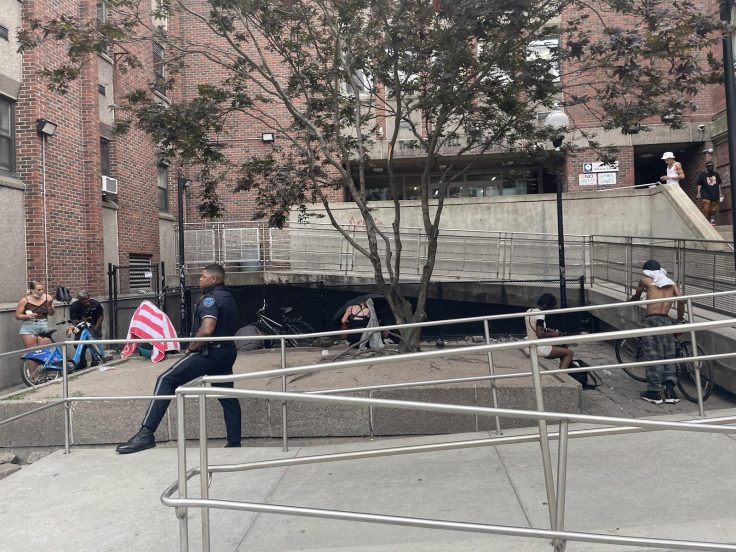BOSTON—The sidewalk surrounding the city government's so-called harm reduction facility in South Boston, which exists to make drug use safe, has devolved into a lawless safe haven for addicts who are free to inject dangerous drugs in plain sight of the city's police force.
The city's drug users congregate outside Access, Harm Reduction, Overdose Prevention, and Education (AHOPE), the Boston Public Health Commission's harm reduction facility, to pick up free drug paraphernalia such as syringes and crack pipes. The Washington Free Beacon saw several users inject in front of the building, where an officer sat inside a parked police car. Remnants of pipes, syringes, and drug capsules filled the cracks in the sidewalk. Security guards at a next-door homeless shelter said police monitor the area to counter violence—which erupts daily between addicts—but otherwise overlook public drug use.
"All the time—violence," one security guard told the Free Beacon.
So far this year, Boston police have made 29 arrests for aggravated assault on the one-mile street outside the AHOPE facility, which neighbors the Boston University Medical Campus and Boston Medical Center, according to police data. Police have also made arrests for 12 robberies, 5 auto thefts, 23 warrant arrests, and 32 "sick assists"—8 of which for "drug-related illness." While Boston police also made 44 arrests for "drug possession/sale manufacturing/use," it is unclear which specific charge was the cause for each arrest. Police officers declined to speak with a Free Beacon reporter on site, and the Boston Police Department did not respond to a request for comment.
The disorder outside AHOPE provides a case study in how the Biden administration's controversial harm reduction approach to drug policy—which aims to make drug use safer for addicts rather than prevent it—can facilitate crime and dangerous drug abuse. The Department of Health and Human Services launched the nation's first federal harm reduction program in May, doling out $30 million in grants to organizations to distribute drug paraphernalia such as syringes and "smoking kits," which often include crack pipes. The White House claimed these funds would not go toward pipes, but several grant recipients distribute the drug supplies, according to a Free Beacon investigation.
Aside from clean pipes and syringes, harm reduction groups such as AHOPE also distribute fentanyl test strips, Narcan, and disease testing, which are intended to mitigate the health risks of drug abuse. Outside the Boston harm reduction facility, however, roughly a dozen drug users each day are rushed to the Massachusetts General Hospital for treatment after they show signs of an overdose, the security guards said.
While the area outside the facility is a de facto harbor for illicit drug use—one drug user said addicts naturally migrate there because of the free drug paraphernalia—formalized injection sites are illegal under federal law. The Biden administration is preparing to declare such injection sites legal, the New York Times reported in July, which would allow people to use drugs with oversight from medical professionals to help prevent overdose deaths. The Trump administration struck down an attempt to open an injection site in Philadelphia, but that decision is set to be overturned by the Justice Department. Injection sites currently operate in New York City.
During one visit to the harm reduction facility, police officers cleared all drug users off the street after declining to speak to a Free Beacon reporter. One of the security guards said that he had only seen police remove everyone from the area "a couple times" since he began working there this year.
"[Police] allow them to shoot up," he said. "But not in front of buildings."
"The good thing is we give them sleep and hope," the security guard added. "The bad thing is you keep the addiction prolonged."
The Boston Public Health Commission and Boston Health Care for the Homeless Program, which treats addicts after they overdose on public streets, did not respond to requests for comment.
